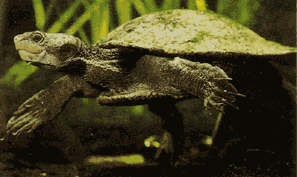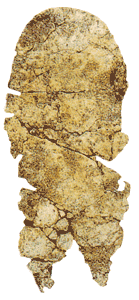 |
|
Shell Game
Carl Zimmer |
 |
| |
  Zoologists sometimes use the term "living fossil" loosely. Its enough for a newly discovered species to belong to a supposedly extinct family or order to earn the name. Much rarer are cases ofg true living fossils, such as that of the Gulf Snapping turtle shown below. Until 1996, zoologists thought the species had died out somewhere between 20,000 and 50,000 years ago. But when herpetologist Scott Thomson of the University of Canberra was asked to identify the shell of an unfamiliar-looking modern turtle found at Lawn Hill Creek in Queensland, he naturally compared it with a snapper fossil that had been found in the same place. Zoologists sometimes use the term "living fossil" loosely. Its enough for a newly discovered species to belong to a supposedly extinct family or order to earn the name. Much rarer are cases ofg true living fossils, such as that of the Gulf Snapping turtle shown below. Until 1996, zoologists thought the species had died out somewhere between 20,000 and 50,000 years ago. But when herpetologist Scott Thomson of the University of Canberra was asked to identify the shell of an unfamiliar-looking modern turtle found at Lawn Hill Creek in Queensland, he naturally compared it with a snapper fossil that had been found in the same place.
Both the living and fossil turtles, he found, share the same distinctive skeletal structure and unusual shell plate arrangement. The only difference was the size: at 13 inches the modern shell (a bottom one is shown at right) is three inches shorter than the fossil shell (upper left). Thomson speculates that in the past more life - and thus, more prey - filled the creek, which may have allowed the turtles to grow bigger. He predicts the snapper will not be the only new species to emerge from north Queensland. "It's in the middle of bloody nowhere and so we humans ignore it," he says. "Lots and lots of new species are going to come out, and not just turtles."
|
|
The above article and the three images are from the January 1997 Discover Magazine article entitled "Shell Game" by Carl Zimmer. The cover of the issue is shown above. Click on the cover to go to the Discover Magazine Web-Site





 Zoologists sometimes use the term "living fossil" loosely. Its enough for a newly discovered species to belong to a supposedly extinct family or order to earn the name. Much rarer are cases ofg true living fossils, such as that of the Gulf Snapping turtle shown below. Until 1996, zoologists thought the species had died out somewhere between 20,000 and 50,000 years ago. But when herpetologist Scott Thomson of the University of Canberra was asked to identify the shell of an unfamiliar-looking modern turtle found at Lawn Hill Creek in Queensland, he naturally compared it with a snapper fossil that had been found in the same place.
Zoologists sometimes use the term "living fossil" loosely. Its enough for a newly discovered species to belong to a supposedly extinct family or order to earn the name. Much rarer are cases ofg true living fossils, such as that of the Gulf Snapping turtle shown below. Until 1996, zoologists thought the species had died out somewhere between 20,000 and 50,000 years ago. But when herpetologist Scott Thomson of the University of Canberra was asked to identify the shell of an unfamiliar-looking modern turtle found at Lawn Hill Creek in Queensland, he naturally compared it with a snapper fossil that had been found in the same place.